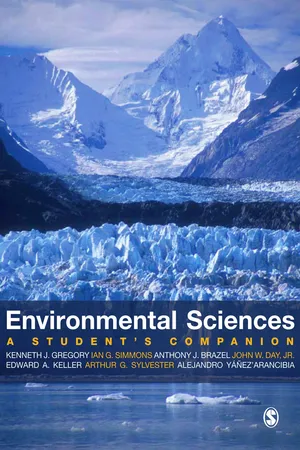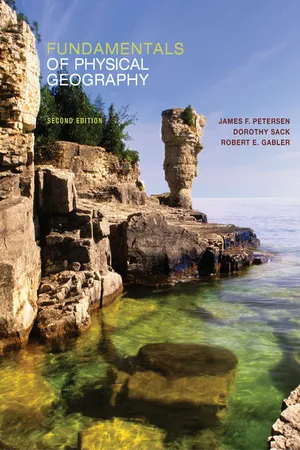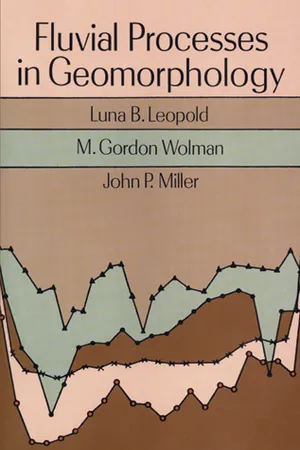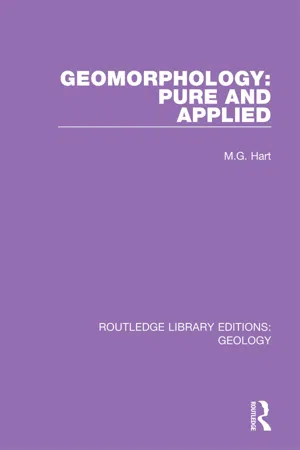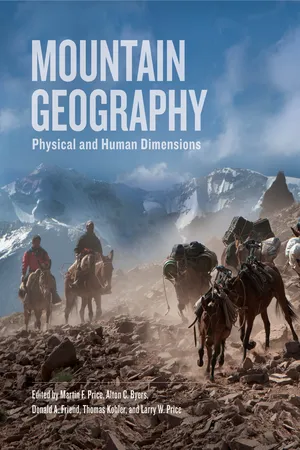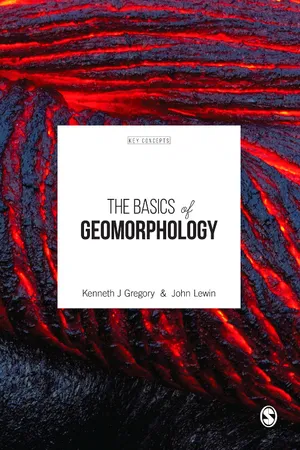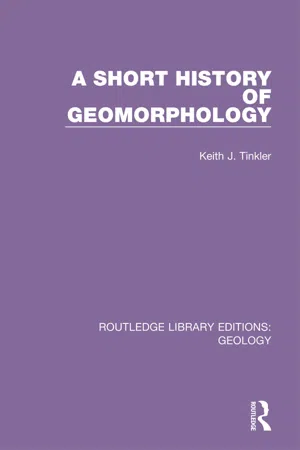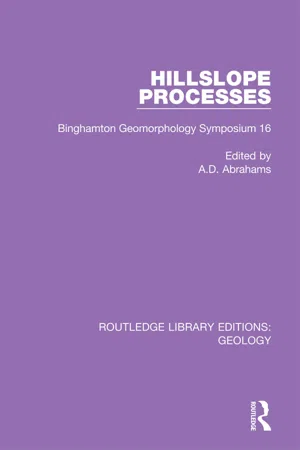Geography
Geological Processes
Geological processes refer to the natural forces and phenomena that shape the Earth's surface over time. These processes include tectonic plate movements, erosion, weathering, and volcanic activity. They play a crucial role in forming landforms, such as mountains, valleys, and coastlines, and contribute to the overall physical geography of the Earth.
Written by Perlego with AI-assistance
Related key terms
1 of 5
12 Key excerpts on "Geological Processes"
- eBook - ePub
- Simon Bell(Author)
- 2012(Publication Date)
- Routledge(Publisher)
Introduction
The previous chapter showed how climate, particularly the aftereffects of the last (but probably not the final) glaciations, has driven and continues to drive many changes occurring in the landscape. The landform patterns and processes which are the subject of this chapter are no exception to this, and in fact in them we can see both the results of climatic processes and their continuing role in modifying climatic processes in the short to medium term, such as volcanic eruptions throwing gas and dust into the atmosphere.The structure and processes of geology supply the basic underlying layer or substrate upon which all terrestrial life and human activities rely. Geology interacts directly with climate to maintain a continuously dynamic state. However, the rates of geological change are generally so slow that for most ecological processes, or considerations for human use, it supplies a relatively stable framework and sets limits or boundary conditions. Areas of ancient shield rocks, where erosion is extremely slow, possess extremely stable geologies. There are places in which dramatic processes occur reasonably frequently, notably in regions with active volcanoes and earthquakes, where processes can disturb and modify ecological or cultural patterns quite dramatically, and occasionally disastrously for anyone living there.It is not the purpose of this chapter to provide a primer on geology, geomorphology or hydrology; instead it is to interpret what we perceive in this field in terms of the patterns and processes, insofar as they help us to read the landscape and to give us a basis for understanding the ecological and human patterns superimposed upon it. The reader should, therefore, feel free to wonder as well as to be stimulated by the amazing structures and awe-inspiring forces at work beneath our feet. - eBook - PDF
Environmental Sciences
A Student′s Companion
- K J Gregory, Ian Simmons, Anthony Brazel, John W Day, Edward A Keller, Alejandro Yanez-Arancibia, Arthur G Sylvester(Authors)
- 2008(Publication Date)
- SAGE Publications Ltd(Publisher)
Surface processes that occur on or above the surface are termed exogenetic, whereas those that occur below the surface are termed endogenetic and sometimes geological. Sometimes Earth surface processes are taken to refer to the geomorphological processes as in the journal Earth Surface Processes and Land-forms published since 1977. Processes affecting the Earth’s surface are dependent upon energy, which can be derived from solar radiation that drives the hydrological cycle, from gravity, whereby position above sea level provides potential gravitational energy, and geothermal energy which derives from the store of heat energy inside the Earth. Operation of Earth surface processes involves interaction of several Earth spheres and the dynamic way whereby energy is transferred through cycles in environmental systems including the rock cycle, the hydrological cycle and biogeochemical cycles and food chains. The range of Earth surface processes (Table 35) therefore interact in many ways, although for convenience they are often investi-gated individually. Thus weathering is interrelated with pedogenic processes of soil formation, mass movements on coastal cliffs interact with coastal processes, and nival processes in periglacial areas operate in combination with fluvial and mass movement processes. Some processes are defined according to the dominance of the materials on which they operate, such Earth Surface Processes 235 Table 35 Earth surface processes Group of Earth surface processes Processes included Summary explanation Geomorphologic: endogenetic Plate tectonics The lithosphere is composed of several large plates that move relative to one another Seismic movements Earthquake activity, folding (orogenesis), uplift of land (epeirogenesis), faults and fault movement Vulcanicity Extrusive volcanic activity where magma or molten rock or associated solids, or gases are extruded on to the Earth’s surface through fissures and volcanoes may be produced. - eBook - ePub
- Cynthia Metcalf, Rhonda Atkinson(Authors)
- 2017(Publication Date)
- Research & Education Association(Publisher)
Geography informs people about the relationships they have between place and environment over time. This element explores how humans modify the physical environment, how physical systems affect human systems, and how the changes occur in the meaning, use, distribution, and importance of resources both in the past and potentially in the future. This element addresses the following standards:1. how to apply geography to interpret the past;2. how to apply geography to interpret the present and plan for the future.COMPETENCY 1.2Identify the ways natural processes and human–environment interactions shape the Earth’s physical systems and features.The Earth’s physical systems and features are shaped and reshaped by natural processes and human interactions with it. Physical processes are nature’s way of producing, maintaining, or altering the physical systems of the Earth. Physical processes can be categorized into four areas:• Air—referred to as atmospheric and includes examinations of climate and meteorology.• Land—referred to as lithospheric and includes examinations of plate tectonics, erosion, and soil formation.• Water—referred to as hydrospheric and examines things like the circulation of the oceans and the hydrologic cycle.• Animals—referred to as biospheric and examines plant and animal communities and ecosystems.There are seven main categories of natural processes that have shaped Earth’s landforms and physical systems and features:• weathering• transportation• erosion• freezing and thawing• gravity• deposition• plate tectonicsMuch of Earth’s landforms - eBook - PDF
- James Petersen, Dorothy Sack, Robert Gabler, , James Petersen, Dorothy Sack, Robert Gabler(Authors)
- 2014(Publication Date)
- Cengage Learning EMEA(Publisher)
283 11 Tectonic and Volcanic Processes and Landforms :: Outline Landforms and Geomorphology Tectonic Forces, Rock Structure, and Landforms Earthquakes Igneous Processes and Landforms Distribution of Tectonic and Volcanic Activity The Alaskan volcano Mount Redoubt erupting steam at sunset. USGS Alaska Volcano Observatory/D. Josefczyk Copyright 2013 Cengage Learning. All Rights Reserved. May not be copied, scanned, or duplicated, in whole or in part. Due to electronic rights, some third party content may be suppressed from the eBook and/or eChapter(s). Editorial review has deemed that any suppressed content does not materially affect the overall learning experience. Cengage Learning reserves the right to remove additional content at any time if subsequent rights restrictions require it. C H A P T E R 1 1 • T E C T O N I C A N D V O L C A N I C P R O C E S S E S A N D L A N D F O R M S 284 geomorphic processes work to shape Earth’s surface land-forms because they are active, ongoing, and often powerful processes that affect human welfare. Landforms are a funda-mental, dynamic, beautiful, diverse, and sometimes danger-ous aspect of the human habitat. Landforms and Geomorphology A basic characteristic of all landforms and landscapes is their relative amount of relief , which is the difference in elevation between the highest and lowest points within a specified area or on a particular surface feature ( ■ Fig. 11.1). With no varia-tions in relief, our planet would be a smooth, featureless sphere and certainly much less interesting. It is hard to imag-ine Earth without dramatic terrain as seen in the high-relief mountainous regions of the Himalayas, Alps, Andes, Rockies, and Appalachians or in the huge chasm that we call the Grand Canyon. Interspersed with high-relief features, large expanses of low-relief features, such as the Great Plains, are equally impressive and inspiring. - eBook - ePub
- Luna B. Leopold, M. Gordon Wolman, John P. Miller, M. Gordon Wolman, John P. Miller(Authors)
- 2012(Publication Date)
- Dover Publications(Publisher)
Similarly, one current earth-history view of geomorphology assumes that enough is now known to interpret landforms and deposits in terms of processes that operated in times past. In the most qualitative way this is probably true. However, we believe that the genetic system breaks down when it is subjected to close scrutiny involving quantitative data. At present deductions are subject to considerable doubt, for the detailed properties of landform have not been studied carefully enough and the fundamental aspects of most geomorphic processes are still poorly understood. So long as this is true, the interpretation of geomorphic history rests on an exceedingly unstable base.Accordingly, we plan to concentrate on geomorphic processes. The emphasis is primarily upon river and slope processes; river processes will receive greatest attention, since the greatest volume of information available is on rivers. Our objective is to synthesize the material on these subjects in an attempt to assess the current status of knowledge and at the same time to draw attention to its shortcomings.Process implies mechanics—that is, the explanation of the inner workings of a process through the application of physical and chemical principles. We realize that some readers may be more interested in descriptions of landforms than in the detailed analysis of the processes that formed them. So far as possible, we attempt to relate the processes discussed to specific types of landforms. Unfortunately, the gap between our understanding of specific processes in microcosm and the explanation of major large-scale landforms is still wide. It is interesting to note that geomorphologists seem to have a better understanding of depositional than of erosional forms. This may be because the formation of depositional features such as sand dunes, deltas, and flood plains is more easily seen in the field, or because many erosional features retain less clear evidence of their mode of formation.Detailed understanding of geomorphic processes is not a substitute for the application of basic geologic and stratigraphic principles. Rather, such understanding should help to narrow the range of possible hypotheses applicable to the explanation of different geomorphic forms and surficial earth processes and deposits.Our approach involves some use of mathematics. We are aware that the feelings of professional geomorphologists about numbers, graphs, and formulas range from acceptance and enthusiasm to bewilderment and forthright hostility. We have not gone out of our way to be mathematical, but wherever we felt that mathematics contributed either clarity or brevity to the discussion, it has been used. Some fundamental principles of mechanics and statistics are introduced in the text where they are appropriate and necessary to an understanding of the subject at hand. Because fundamental principles of geomorphology are drawn from both mechanics and geology, some readers—depending on their backgrounds—will find specific explanations oversimplified to suit their taste, while others will find the same material wanting in simplicity. Although we have attempted to achieve balance in this regard, the wide spectrum of readers’ interests and background in the subject suggests. that a perfectly happy medium is not likely to be attained at this time. - eBook - ePub
Hydrogeology
Principles and Practice
- Kevin M. Hiscock, Victor F. Bense(Authors)
- 2021(Publication Date)
- Wiley-Blackwell(Publisher)
3 Groundwater and Geological Processes3.1 Introduction
This chapter discusses the response of groundwater systems to Geological Processes such as plate tectonics, glaciation and sea‐level fluctuations. Although topography‐driven groundwater flow, as introduced in Chapter 2 , is in many areas of the world the dominant mode of groundwater circulation, consideration of the additional impact of Geological Processes on groundwater flow is often important to fully appreciate the dynamics of groundwater systems on relatively long timescales (millennia). For example, only by considering the hydrogeological impacts of glaciation and associated sea‐level low stand, can the occurrence of fresh water underneath the sea‐floor along much of the continental shelf be understood. In the description of regional groundwater flow systems, which typically reach circulation depths of several kilometres, flow driven by the variable density of groundwater and flow induced by stresses imposed on pore fluids play an important role and often form the sole driver of fluid flow in the absence of topographically driven flow. The variable density of groundwater and anomalous pore pressures can be caused by a suite of Geological Processes. Thus, to understand fluid flow patterns in relatively deep hydrogeological systems requires an understanding of how the relevant Geological Processes cause fluid flow. It is the task of the hydrogeologist to evaluate, for a given geological setting, which processes can be expected to be dominant in driving fluid flow in the subsurface.The way groundwater and other geofluids, such as hydrocarbons, respond to geological forcing often has a direct feedback on how Geological Processes proceed. This feedback mechanism is, for example, important when the influence of fluids on seismicity should be considered. In this chapter, however, discussion will be limited to a more or less one‐way description of the primary impact of Geological Processes on fluid movement in the Earth’s crust, while a consideration of feedback mechanisms would be the topic of a more specialized discussion than covered here. - eBook - ePub
- M.G. Hart(Author)
- 2020(Publication Date)
- Routledge(Publisher)
The main aspects of process geomorphology will now be reviewed. However, it must be remembered that process studies are by no means without difficulties. Field work can be awkward, with processes operating with a duration and an intensity that make their study problematical. Processes in nature act in combination; how does one separate out one for analysis? The link between process and form is not always obvious; form can influence process. And, possibly most important, although we know what happens in general terms and can observe the results of process, our knowledge of the detailed mechanism of many processes is not complete. As will be seen shortly, this is a field in which geomorphologists have been busy.Weathering, biological processes and soils
The various recent textbooks on weathering, such as Oilier (1969) and Carroll (1970), adopt slightly different approaches to the topic, but a useful classification of weathering processes is as follows.(a) Processes of disintegration:(i) Crystallisation processes – salt weathering and frost weathering.(ii) Temperature-change processes – insolation, exfoliation.(iii) Weathering by wetting and drying.(iv) Organic processes such as root wedging and colloidal plucking.(b) Processes of decomposition:(i) Hydration and hydrolysis.(ii) Oxidation and reduction.(iii) Solution and carbonation.(iv) Chelation.(v) Biological chemical changes.For the most part this will be a familiar list, but for readers who are keen to see the modern developments certain points are worth stressing. First is the great significance accorded to crystallisation processes. They are generally the most important agents in the natural weathering of building stones in Britain. Second is chelation, which involves the holding of an ion, usually a metal, within a ring structure of organic origin. Chelating agents can extract ions in otherwise insoluble solids, and enable the transfer of ions in chemical environments where they would normally be precipitated. - eBook - PDF
Mountain Geography
Physical and Human Dimensions
- Martin F. Price, Alton C. Byers, Donald A. Friend, Thomas Kohler, Larry W. Price, Martin F. Price, Alton C. Byers, Donald A. Friend, Thomas Kohler, Larry W. Price(Authors)
- 2013(Publication Date)
- University of California Press(Publisher)
The exact outcomes depend on local circumstances, but the more resistant the rock, the more likely it is to produce peaks and ridges. Joints, fractures, and fault lines are zones of weakness and can experience more weathering. Streams exploit such fea-tures and develop preferentially along them, providing a good indicator of an area’s structural framework. While structure and rock type exert significant control on landform development, they are also largely innate and unique in their character and distribution, depending upon internal processes. External processes operating at the surface of the Earth, such as precipitation, temperature, or other climatic variables, display a very different distri-bution. Climate provides the basic framework into which all natural phenomena must fit. It is obvious that environ-mental conditions (temperature and precipitation) vary with climate type. Therefore, despite widespread regional differences in the character of mountains, many pervasive and overriding similarities suggest that similar geomorphic processes operate under comparable environmental condi-tions and give rise to similar types of landforms. Landscape Development As early as 1850, scientists began to question how flat ero-sional surfaces formed or why unconformities—breaks in the building structure—existed. The ideas of William Mor-ris Davis coincide with these early attempts to reconstruct the denudational history of the Earth, the weathering and erosional processes that contribute to lowering land. Charles Darwin influenced the popular trend of thought during this period; as a result, Davis applied evolutionary ideas and terminology to describe landforms and the land-scape. In 1889, Davis first presented his explanation of the erosion cycle, which explained landform development by investigating the rivers and valleys of Pennsylvania. He assumed that the landscape experienced an initial rapid tectonic uplift. - eBook - ePub
The Basics of Geomorphology
Key Concepts
- Kenneth J Gregory, John Lewin, Author(Authors)
- 2014(Publication Date)
- SAGE Publications Ltd(Publisher)
Figure 5.2) which requires general ‘laws’ concerned with the functional nature of landforms, the immanent properties of Earth surface processes, and the adjustment of form to process.More specific ways to achieve a holistic approach have underlined reviews and statements about future needs and foci such as the US National Research Council’s committee on Challenges and Opportunities in Earth Surface Processes (see Murray et al., 2009). Prompted by governments requiring society benefits from their research funding, there has been the perception that few environmental challenges are likely to be solved by a single discipline because integrated approaches and interdisciplinary collaboration are often required. Individual suggestions have also been made, such as that of Lang (2011), to develop a computer modelling framework – an ‘Earth surface simulator’ – which would combine process understanding and evolutionary information to provide a unifying platform comparable to GCM technology. This could represent dynamic process interactions, including interfaces to the lithosphere, biosphere and atmosphere.It has been suggested that three alternative foci can now be perceived (Gregory, 2010): geographical, interpreting morphology and processes; geophysical macro geomorphology, concentrating upon the broad structural outlines (see Church, 2005; Summerfield, 2005b); and chronological historical/Quaternary, focused on the history of change. However, these are much more connected, perhaps requiring a holistic approach, than approaches established in geomorphology since the late 19th century. Specialisms have greatly increased, with scientific compartmentalization, so that for example understanding the advantages and limitations of particular dating techniques is in a different realm from understanding GIS procedures. But the understanding of landforms, for practical management purposes in particular, may require forms of overarching collaboration as much as a highly focused specialism. - eBook - ePub
- Keith J. Tinkler(Author)
- 2020(Publication Date)
- Routledge(Publisher)
Chapter ElevenSTUDIES OF LANDFORM PROCESSES AND LANDSCAPES SINCE THE 1960s
Davis’s great mistake was the assumption that we know the processes involved in the development of landforms. We don’t; and until we do we shall be ignorant of the general course of their development(J. Leighly, 1940)Contemporary records of geomorphological processes are not likely to represent long-term behaviour sufficiently well to provide any firm basis for understanding landscape evolution.(M. Church, 1980)It is extremely difficult to keep entirely separate the study of landscape processes from the landforms they create. Indeed, such a split, strictly observed, would be contrary to the whole purpose of geomorphological enquiry. However, over the last two decades the emphasis on process has been such that for the purposes of discussion two separate headings are possible. Nevertheless, aspects of one will inevitably leak into the other, and I have provided a section on conceptual and theoretical advances to act as a bridge both between sections, and between what may be, and what ought to be, converging schools of thought.THE SHIFT TO PROCESS STUDIES General and institutional indicatorsThe switch to studies of landform processes from those of regional landscapes was accomplished within a few years in the United Kingdom. It had already been accomplished in the United States, but was much more muted on the continent, where interest in processes accompanied a prevailing interest in climatic geomorphology with its inevitable focus on regional scale landforms. In tropical countries the response was a lagged echo from European interests. - eBook - ePub
Hillslope Processes
Binghamton Geomorphology Symposium 16
- A.D. Abrahams(Author)
- 2020(Publication Date)
- Routledge(Publisher)
The problem of “the everlasting hills” was more severe than in most other branches of geomorphology. Rivers obviously flow, carry sediment, and from time to time their banks collapse; marine cliffs in soft rocks recede rapidly, whereas glaciers move perceptibly even within the timespan of an expedition. But in most parts of the world, especially the smooth, soil-covered landscapes of western Europe, change on slopes is not apparent in a human lifetime. Both authors experienced the revelation, on their first visits to the Rocky Mountains, that landscapes really are alive. For a time, geomorphology was imbalanced, with a modern, process-oriented textbook on rivers (Leopold et al., 1964) but nothing comparable in other branches.Michaud began to survey movements of painted stones in the Alps in 1947, Schumm measured ground loss on badlands from 1952 onwards, and Rougerie started wash measurements in the Ivory Coast. Grove recorded the daily movement of a mudflow, and Young put wooden pegs into the ground surface below rock outcrops.Since that time, instrumentation has been developed to measure all the processes on slopes: soil creep, solifluction, surface wash, landslide movement, and latterly throughflow and solution. The stages in obtaining rates of movement are basically similar whatever the process: (1) develop the instrumentation necessary to record very small changes; (2) measure these changes, usually over a period of 1–3 years; and (3) extrapolate the results in time and space.Within the context of the exponential growth in geomorphology as a whole, this procedure gave rise to a steadily growing stream of published rates of slope processes, from some 10 per year in the 1960s to over 40 per year in the 1980s. Three times we have attempted to summarize and compare such reports, for total denudation (Young, 1969), and for slope processes, slope retreat, and total denudation (Young, 1974; Saunders and Young, 1983). On the last occasion our report covered 419 publications and was by no means complete. Further updatings of this nature will probably have to be made for individual processes or climatic environments. - eBook - ePub
Arid Zone Geomorphology
Process, Form and Change in Drylands
- David S. G. Thomas(Author)
- 2011(Publication Date)
- Wiley(Publisher)
The macro-scale explanation uses variations in climate and tectonics to evaluate how these internal processes might be affected over different timescales. This approach thus ties into the discussion above about tectonic and climatic impacts on badlands, but also other elements of landscape interconnectivity such as river capture (e.g. Mather, Stokes and Griffiths, 2002); Griffiths et al., 2005). Figure 10.11 Slick rock sandstone of the Entrada series in South western USA. 10.3 Rock slopes Rock slopes occur where the geological substrate is exposed via processes such as water and wind erosion (of soils) and mass movement (of parent material). The relative speed of erosion relative to weathering processes in drylands (Chapter 6) results in these conditions occurring frequently. In arid zones, such geology is often sedimentary in nature, overlying (or underlying) older and deeper crystalline bedrock, as in the slick-rock, sandstone slopes of the southwestern United States (Figure 10.11). Rock slopes are found in the shield-platform deserts of the world (see Mabbutt’s (1977) classification), across Africa, Arabia, Australia and India. Their form is characterised by retreating cuestas, mesas and buttes, with rate of formation being controlled by the geological form of the dominant bedrock in interaction with the rate of surface weathering and mass movement processes. Herein, rock slopes are categorised as (1) gravity-controlled, where slopes are steep and slope failure is typified by rockfalls leading to predominantly bare profiles or (2) rock (débris)-mantled slopes that are lower in gradient and are typically controlled by both mass movement and erosional processes. In many dryland locations, these different slope units occur as a continuum of slope evolution with steep, bare rock slopes occupying the upper section of a hillslope, near the divide or free face of a cuesta and rock or debris-mantled slopes occupying a mid-slope location, where debris has accumulated
Index pages curate the most relevant extracts from our library of academic textbooks. They’ve been created using an in-house natural language model (NLM), each adding context and meaning to key research topics.

